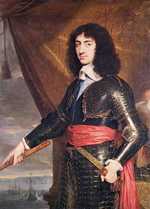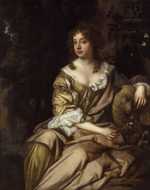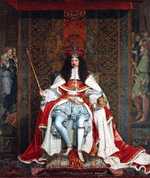1. Charles II's Early Life
Charles II was born at St. James Palace in London on May 29th, 1630, a son to King Charles I and Henrietta Maria.
He was educated by the Bishop of Chichester and the Earl of Newcastle in an early childhood which befitted a King’s son and was given the title of Prince of Wales when aged eight. However political unrest was already brewing and when the civil war began in 1642 his formal education came to an abrupt end.
His father wholeheartedly believed in a king’s divine right to rule, something his son would also believe as King Charles II.
However this conflict of power between monarchy and parliament was to spill over on to the battlefield in a civil war, which over a series of engagements was to last nine years. The young Charles was to support his father against the Parliamentary forces and when still only 14 years of age was made nominal commander of the English forces in the West country.
The Royalist cause was all but lost in 1645 and as heir to the throne young Charles was helped to flee the country. He joined his mother in France via the Scilly Isles and Jersey, before taking up residence at The Hague in the Netherlands.
It was here he was informed of his father’s execution in 1649, before one more plot was hatched to try and save the embattled monarchy.
2. Exile and Restoration
Following the execution of the king, Scotland proclaimed the exiled prince as King Charles II.
As part of the deal Charles had to accept Presbyterian church governance in the British Isles and in 1650 he landed in Scotland from where he led an invading force across the border in to England. However, their defeat at the Battle of Worcester in 1651 by Oliver Cromwell’s Parliamentary army signalled the end of the civil war.
Charles II managed to escape capture, hiding in an oak tree to avoid Roundhead troops according to folklore, before returning to exile with the help of subjects who remained loyal to the crown.
Exile was hard for Charles as Oliver Cromwell, Lord Protector of the newly formed Commonwealth, put pressure on those looking to host the exiled king in waiting. He initially joined his mother in Paris, before moving to Cologne for diplomatic reasons and then Bruges in the Spanish Netherlands, as Charles increasingly looked to Spain for help in winning back his crown.
In 1658 Oliver Cromwell died and although his son Richard was named Lord Protector he lacked his father’s authority. As a power struggle developed within England which threatened to return the country to turmoil, many saw the return of the monarchy as the only chance to bring peace and stability back to the nation.
Chief among these was General Monck who had been one of Cromwell’s leading Generals. In 1660, with the help of chief adviser Edward Hyde, Charles issued the Declaration of Breda in which he promised a pardon for crimes committed during the civil war to those who now recognised him as King. In May 1660 Charles II was proclaimed King and on 30th May he entered London, five days after landing back in England at Dover.
3. The Reign of King Charles II
The new King was to realise early on that he was not going to get everything his own way with Parliament.
His attempts to introduce toleration for Catholics were repeatedly rebuffed and indeed the Clarendon Code was passed which discouraged non-conformity to the Church of England. Suspicions about Charles II being an uncommitted Anglican dogged his reign and were not helped by his marriage in 1662 to the catholic Catherine of Braganza as part of an alliance with Portugal.
In the space of two years King Charles II faced two of the biggest challenges of his reign. The year 1665 saw the Great Plague of London decimate the city, with death tolls of up to 7000 every week as the disease spread without means of control. The King and his family escaped London, ultimately taking up residence in Oxford.
By early 1666 cases of the plague had dropped and there were sporadic outbursts until the second disaster struck the city in September that year. The Great Fire of London destroyed a huge swathe of London, including St Paul’s Cathedral, but is also often seen as the end point to the Great Plague. King Charles II and his brother James were highly visible for this tragedy, riding around the stricken city organising the response on the ground.
At the same time as these disasters the country was faring badly in the Anglo-Dutch war. The Dutch victory included a demoralising raid on Chatham Dockyard to attack the anchored British fleet.
In 1670 Charles agreed a controversial secret treaty with the French king Louis XIV, where he agreed to convert to Catholicism and support the French war effort against the Dutch in return for financial assistance which would help him in his dealings with Parliament. Although Charles ensured the terms remained secret and only converted on his deathbed, it was still a clause the French King could hold over him for influence.
The Popish Plot of 1678 ramped up the pressure on a King whose religious inclinations were already doubted by many of his subjects. Based around a Catholic plot to kill the King, allegedly uncovered by Titus Oates, a former Anglican Cleric, it was all complete fiction which all too easily tapped in to a population’s anti-catholic sentiment.
The plot would put Charles’ brother James, who had already converted to the Catholic church, on the throne. It triggered the exclusion crisis as parliament looked to exclude James from the succession.
In response to the crisis King Charles II dissolved parliament in 1681 and ruled the nation for the remainder of his reign as an absolute monarch. He died on February 6th 1685 at Whitehall Palace in London, converting to Catholicism on his death bed, to be succeeded by his brother James.
4. King Charles II's Legacy
The marriage between Charles II and Catherine of Braganza bore no children and the Catholic James succeeded to the throne.
During his lifetime King Charles II had a number of high profile mistresses including Lucy Walter, Barbara Villiers, Louise de Keroualle and Nell Gwyn. He fathered many children through these affairs, but only one, James Crofts, was to become involved in the world of politics.
A favourite of Charles II, James Crofts was made Duke of Monmouth in 1663. As a protestant Monmouth was a strong opponent of James’ succession to the throne and led an unsuccessful rebellion in 1685. However the daughters of James had been raised as Anglican on the wishes of King Charles II and the eldest, Mary, was married to the Protestant William of Orange in 1677. The Glorious Revolution of 1689 saw William and Mary crowned joint monarchs after invading England in 1688, which saw James flee abroad.
Although referred to as ‘The Merry Monarch’ who overlooked a lively court which indulged in pleasure at every opportunity, King Charles II was also a patron of the arts and took an interest in science.
During his reign he commissioned the Royal Observatory at Greenwich and supported the Royal Society, giving it royal approval in 1663. A notable achievement of the reign of King Charles II was the rebuilding of London following the Great Fire in 1665, in which Christopher Wren oversaw much of the process including the later design and rebuilding of St. Paul’s Cathedral.
The King teamed up with Wren once more when the architect brought to life the monarch’s wish for a hospital for veteran soldiers. A royal warrant was issued in 1681 to build the Royal Hospital Chelsea, a project which was completed in 1692. The Chelsea Pensioners remain well known across the world and a statue of the king which was commissioned around the same time still stands in the hospital grounds today.
For all the disputes between parliament and King Charles II, plus his subjects concern over his religious toleration, he is viewed as a generally popular King having brought stability back to the country after the collapse of the Commonwealth.
He certainly liked the finer things in life and loved regaling the tale of his escape following the battle of Worcester, particularly revelling in how he was able to easily disguise himself and pass as a common man. King Charles II was buried in Westminster Abbey in a ceremony which was low-key, possibly due to his death bed conversion to the Catholic church. A life size wax effigy was made of the King in 1686 and is displayed in the Islip chapel.
















